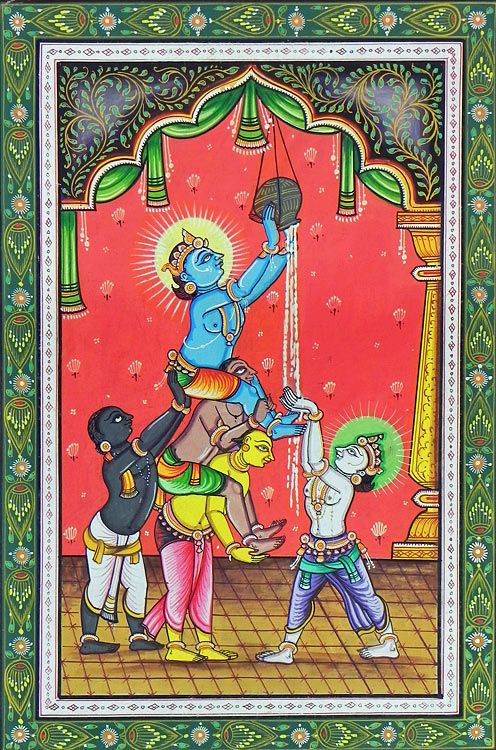This is a six part article detailing the Artha Panchaka – The Five Requirements of a Srivaishnava based on The Handbook of Srivaishnavism by U Ve Sri Rama Ramanuja Achari of Sri Matham
The Nature of the Godhead
(Para-svarupam)
The universe around us is seen to be a constantly changing highly complex phenomena which is impermanent. Behind this transitory phenomena lies an unchanging eternal substratum (noumenon) upon which these effects take place. This can be likened to a movie which is projected upon a screen. The screen is the unchanging substratum upon which the great drama is played out. Similarly this universe with all its myriad of effects takes place upon a screen which is the Absolute Ultimate Reality. The term “Absolute” is derived from the Latin and means free from any limiting conditions or restraints. According to Vedanta, the
Absolute Ultimate Reality which is the cause and the basis of the universe is called Brahman which means the “The Immensity” in Sanskrit. Through a process of logical reasoning the existence of an intelligent Supreme Reality behind the transient ephemeral universe can be reached. But the actual existence of th!e Godhead (the Divine Nature) cannot be demonstrated, and nothing affirmative can be said about it which is subject to scientific investigation and proof.
It must be stressed that the Ultimate Truth cannot be known by the human mind which functions through duality and antithetical comparison. The Absolute which by definition is beyond all our conceptions and ideas and transcends the limitations of time, space and causation, cannot be contained and limited by our thought processes. All attempts to verbally describe anything result in varying degrees of ambiguity, but do not convey the essential meaning. In the same way all attempts to describe the Divine are metaphors and symbols indicating the way - we should follow the signs and not argue about their form.
Ramanuja declares that the existence of a Supreme Godhead cannot even be inferred because inference is based upon a perceived and demonstrable coexistence between cause and effect (such as the connection between smoke and fire). God and the world cannot be demonstrated to have a concomitance and therefore cannot be inferred through reason. It is only through Divine Revelation - the Vedas, Upanishads and Bhagavad Gita etc. that anything at all can be known about the Supreme Being.
According to Vedanta, the Absolute Reality or Godhead is known as Brahman is the unitary source from which all manifestation proceeds. Brahman is a Personal Being in terms of being characterised by infinite and expansive auspicious qualities and devoid of all imperfections. His nature consists of consciousness, existence, eternality, purity and bliss absolute. This Supreme Being or Brahman is referred to in the Vedas by many names but the most prominent of them is Narayana an epithet which embodies all the essential qualities of the Godhead. It means “The Ground of all Being”. Various definitions of the name Narayana are given such as:—
The Super-Self, the Support and repository of all Selves. The Prompter of the actions of all beings from within their hearts. The Witness (Observer) of the entire universe.In the Bhagavad Gita the Lord shows His comic form to Arjuna and this theophany appears primarily as an all-expansive cosmic light - refulgent as a thousand suns.
11:12. If a thousand suns were to rise at once in the sky, the resulting magnificence may be (somewhat) like the effulgence of that mighty One.Again and again we find statements in the Scriptures which declare the nature of the Supreme Being to be inconceivable and inexpressible. Ramanuja in his preamble to the Gita affirms:-
“God has a divine form, which is both pleasing and appropriate. His form is inconceivable, indescribable, divine, eternal and immaculate.”
So whenever we use anthropomorphic terms to describe and to communicate information about the Divine we must do so with the understanding that words are all totally inadequate to serve as vehicles of the Truth; they are merely flimsy pointers, concessions to our human limitations. All human cognition is dependant upon fixed reference points - pairs of opposites, and therefore, that which is beyond the pairs of opposites cannot be comprehended. A paper cup is not a fit vessel in which to contain that Supreme Expansive Light of Truth - the brilliance of a thousand suns! We need to avoid the folly of thinking about the Supreme Being and the transcendental realms as a Spiritual “Disney Land”!
1:1 Essential Nature of the Godhead
In the Upanishads which are the concluding portions of the Vedas, five attributes are revealed which define the essential nature of the Supreme known as Brahman or “that which expands ad infinitum”; they are known as the five metaphysical qualities called svarupa-nirupaka-dharma. These are the ‘incommunicable’ attributes which emphasise the absolute Being of the Godhead, they are:-
• satyam - Truth - this is the attribute of absolute non-conditioned self-existence. The Godhead exists by Itself and for Itself. It is not subjected to any form of change or modification, nor is It dependant upon anything whatsoever. There is nothing in the Universe which the Godhead requires for Its existence, It is entirely self-fulfilled and self-content.
• cit - Omniscience - The omniscience which the Godhead possesses is archetypal, which means that It knows the universe as it exists in Its own mind as an Idea before it came into being as a finite reality conditioned by time and space. Its knowledge is not obtained like human knowledge from sources outside - it comes from within. It is absolute omniscience; perfect and unobstructed knowledge of everything as it is - past present and future.
• anantam - Infinitude - the Supreme Being is not subjected to any limitations of time or space, It is omnipresent or present everywhere at once. This definition refers both to Its essential Being and Its attributes; both of which are all-pervading.
• anandam - Beatitude - the Godhead possesses unsurpassable indescribable bliss and is also the essence of bliss. Any joy or sensation of bliss which we may experience as human beings is like a drop in the ocean of bliss which is God’s.
• amalam - Purity - the Godhead is pure and immaculate and eternally free from all taints and imperfections. The term ‘amalam’ has a moral connotation in that the Divine Nature is the embodiment of moral and ethical perfection - It is never bound by kaa.
The other group of attributes of the Godhead namely the “communicable” attributes which emphasise moral perfection and personability will be discussed under the section on redemption.
Although we mostly talk of the Godhead in masculine terms, Vedantic theology conceives of a duality of gender in the essential unity of the Godhead. God is always conceived of as being accompanied by His eternal and inseparable consort Lakshmi. This topic is also taken up for discussion in the section on redemption.
1:2 The Five Facets of the Divine
The Divine Nature, is both immanent and transcendent. By immanent we mean that It is present within the world. It is all-pervading and is the ground of all finite existence and activity. Transcendent means that the Divine Nature is not limited to dwelling within the manifest universe but also encompasses it. The metaphor often used to describe these two aspects is the fish in the sea - the sea is immanent in the fish and transcendent as the ocean in which the fish has its existence. The Divine Nature is not normally perceptible to the senses, but theologically manifests Itself in five forms;
1. The transcendental form. para
2. Functional manifestation. vyuha
3. Incarnations. avatara
4. Iconic descent. arca
5. Indwelling witness antaryamin
The Transcendant Form - Para-vasudeva
This transcendental form of the Divine Nature is absolute, unconditioned and unlimited. It is self-existent and is not the effect of anything else. The transcendence of the Godhead is impossible for any human being to understand. It is stated that even the devas (gods) do not know it!
The Blessed Lord said:
It is extremely difficult to behold this form of Mine which you have seen. Even the gods ever long to behold this form. Gita 11:52
It is impossible to describe this transcendent nature of the Godhead. The nearest description we can give is to refer to the Godhead as “an ocean of perfection and bliss.” This form is located in a supreme transcendental realm called Parama-pada (‘the Supreme Abode’) or Vaikuntha (‘the unobstructed state’). While discussing “realms” (lokas) it is important to understand that location in space only has relevance to the physical universe. God transcends both space and time, the realm of Vaikuntha (‘the unobstructed state’) also transcends space and time and therefore it is futile to even try to imagine a location for this realm in the physical universe or one of the galaxies! The mystic tradition described realms as inner states of our own being rather than external places.
The Transcendental Divine Nature is distinguished by 6 attributes which have given It the title of Bhagavan;
to be continued…





This is one of the most beautiful articles I have read.I look forward to more of the other parts.One has to read many times even to understand the significance behind the words and meaning.Thank you.